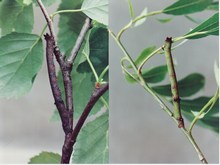Polyphenism

Polyphenism is a kind of polymorphism where different forms of an animal are caused a single genotype. The animal inherits the capability, but the environment determines which form develops. This contrasts with genetic polymorphism,[2] where each morph (form) inherits a slightly different genome.
Polyphenism occurs when the animal inherits a developmental switch. The switch is sensitive to some environmental cue or trigger. For example, the sex of crocodiles is determined by the prevailing temperature. Their gender is a polyphenic trait, and is not determined by the usual sex linkage.[3]
Other examples[change | change source]
The caste system in insects[change | change source]
The caste system of social insects is the division of labor between genetically identical individuals. Polyphenism determines whether larvae develop into queens, workers, and in some cases soldiers. In the case of the ant, P. morrisi, an embryo must develop under certain temperature and photoperiod conditions in order to become a reproductively-active queen.[4] This allows for control of the mating season, but like sex determination, limits the spread of the species into certain climates. In bees, "royal jelly" provided by worker bees causes a larva to become a queen. Royal jelly is only produced when the queen is aging or has died.
Seasonal changes[change | change source]
Polyphenic pigmentation is adaptive for species which reproduce several times a year. Different pigment patterns provide camouflage throughout the seasons, and alter heat retention as temperatures change.[5] Because insects cease growth and development after they are adults, their pigment pattern is set in adulthood. In the case of the peppered moth, Biston betularia, the caterpillars are polyphenic. Their trigger is switched by the colour of the plants they are eating: see this.[6]
-
Junonia almana, wet season form (upper side)
-
Junonia almana, dry season form (upper side)
-
Junonia almana, wet season form (under side)
-
Junonia almana, dry season form (under side)
References[change | change source]
- ↑ Noor MA, Parnell RS, Grant BS (2008). Humphries, Stuart (ed.). "A reversible color polyphenism in American Peppered Moth (Biston betularia cognataria) caterpillars". PLOS ONE. 3 (9): e3142. Bibcode:2008PLoSO...3.3142N. doi:10.1371/journal.pone.0003142. PMC 2518955. PMID 18769543.
{{cite journal}}: CS1 maint: multiple names: authors list (link) - ↑ Ford E.B. 1975. Ecological genetics. 4th ed, Chapman & Hall, London.
- ↑ Woodward D.E. and Murray J.D. 199). On the effect of temperature-dependent sex determination on sex ratio and survivorship in crocodilians. Proc. R. Soc. Lond. [B] 252:149-155.
- ↑ Abouheif, E.; Wray, G.A. (2002). "Evolution of the gene network underlying wing polyphenism in ants". Science. 297 (5579): 249–252. Bibcode:2002Sci...297..249A. doi:10.1126/science.1071468. PMID 12114626. S2CID 33494473.
- ↑ Braendle, C.; Flatt, T. (2006). "A role for genetic accommodation in evolution?" (PDF). BioEssays. 28 (9): 868–873. doi:10.1002/bies.20456. PMID 16937342.
- ↑ Noor MA, Parnell RS, Grant BS (2008). Humphries, Stuart (ed.). "A reversible color polyphenism in American Peppered Moth (Biston betularia cognataria) caterpillars". PLOS ONE. 3 (9): e3142. Bibcode:2008PLoSO...3.3142N. doi:10.1371/journal.pone.0003142. PMC 2518955. PMID 18769543.
{{cite journal}}: CS1 maint: multiple names: authors list (link)




